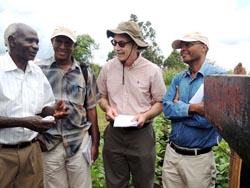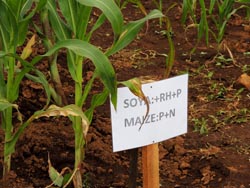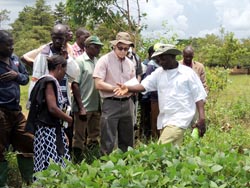"Can the use of soyabean inoculants reduce the use of nitrogen fertilizers? How much fertilizer should soyabean farmers continue to apply in subsequent seasons? What are the long term effects of fertilizers, inoculants and soyabean and maize intercropping? N2Africa tries to find out," said Freddy Baijukya, Country Coordinator for N2Africa in Tanzania.
The soyabean field trials result in recommendations on how to minimize the use of fertilizers by maximizing the fertilizers applied and inoculants. Therefore, lead farmers are using inoculants and fertilizers while growing their soyabean. Lead farmers are also rotating soyabean and other crops such as maize and they applying fertilizers on the maize.
A team of N2Africa researchers, staff and partners from Agricultural Research Institute at Uyole (ARI Uyole), International Institute of Tropical Agriculture (IITA), International Center for Tropical Agriculture (CIAT), the International Crops Research Institute for the Semi-arid Tropics (ICRISAT), One Acre Fund and Farm Inputs Promotion Services (FIPS), Jeff Ehlers, Senior Porject Officer for N2Africa of the of the Bill & Melinda Gates Foundation visited N2Africa soyabean trials in the Southern Highlands of Tanzania.
 |
 |
 |
A member of Umoja farmers group sharing feedback on the soyabean trials (left), long term trials on soyabean and maize (middle) and Joseph Mompesh showing the soyabean field trials (right)
The visited field trials in the Mbeya Region are being conducted by Agricultural Research Institute at Uyole (ARI Uyole) and the International Institute of Tropical Agriculture (IITA). The visited farmer’s demonstration fields at Ivwanga village, Mbezi district are being conducted by Umoja farmers group in collaboration with ARI-Uyole and N2Africa. Farmers use these demonstration fields to select the most preferred soyabean variety for official release in the region.
"We are growing these three new varieties to select the one we prefer the most. As you can see some are already looking very promising. But we cannot tell for now until we harvest. Then we will see which will have the best yield and we will recommend this to the researchers," explained Joseph Mompesh, a lead farmer who acts as a link between farmer and researchers.
The results from the field trials and demonstration fields 2015 and 2016 help to promote the production of soyabean in Tanzania and tackle poverty and malnutrition.
Catherine Njuguna
